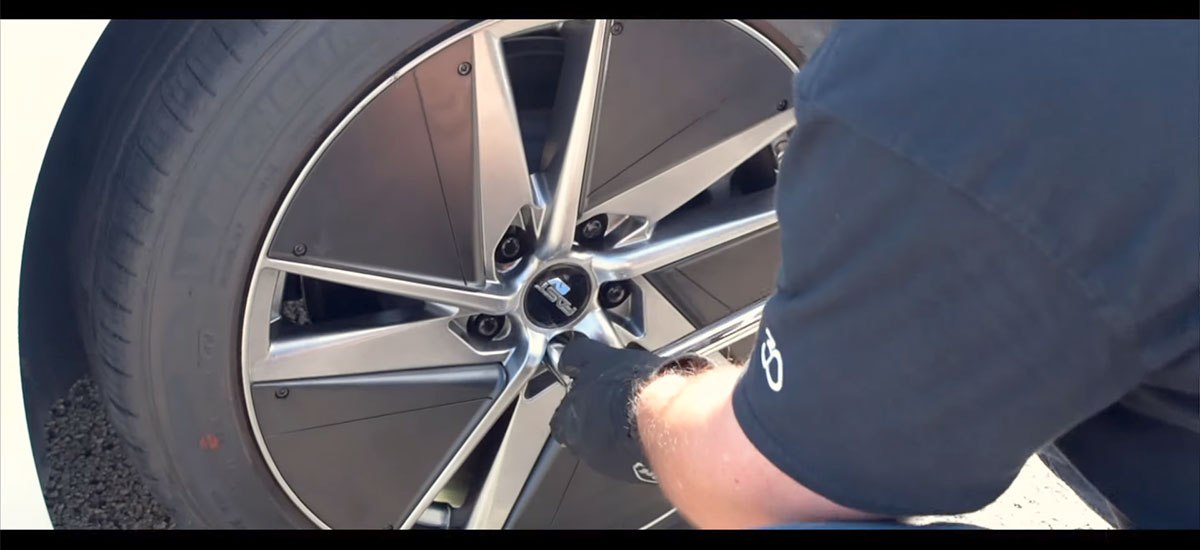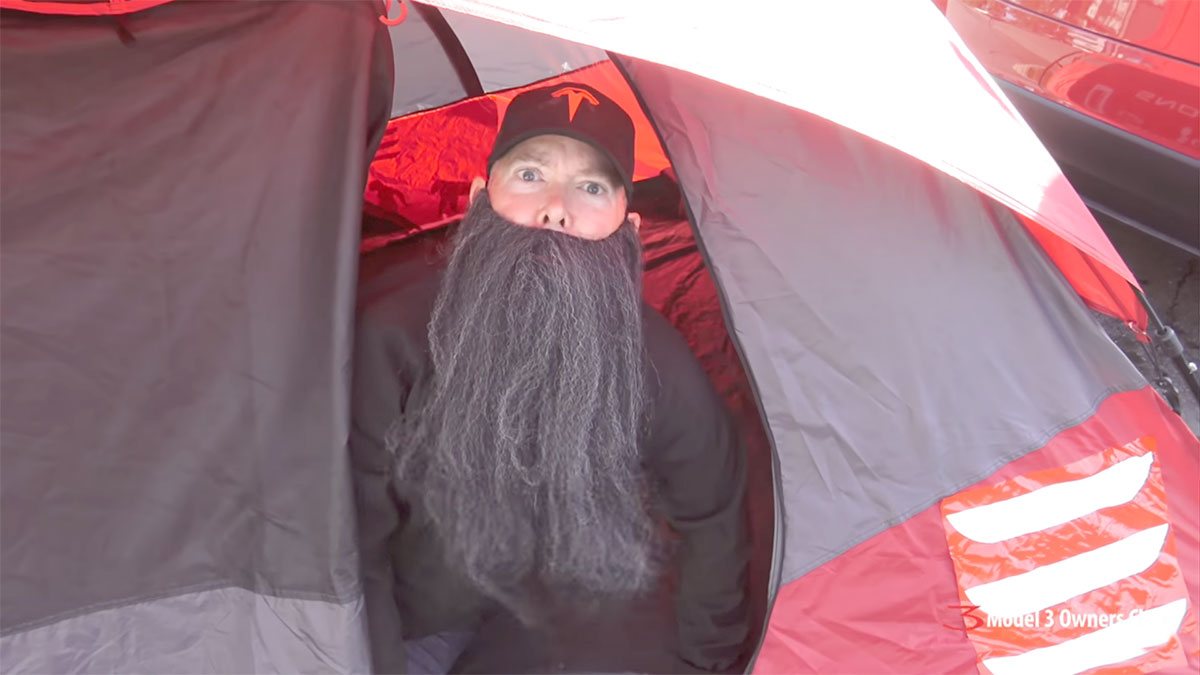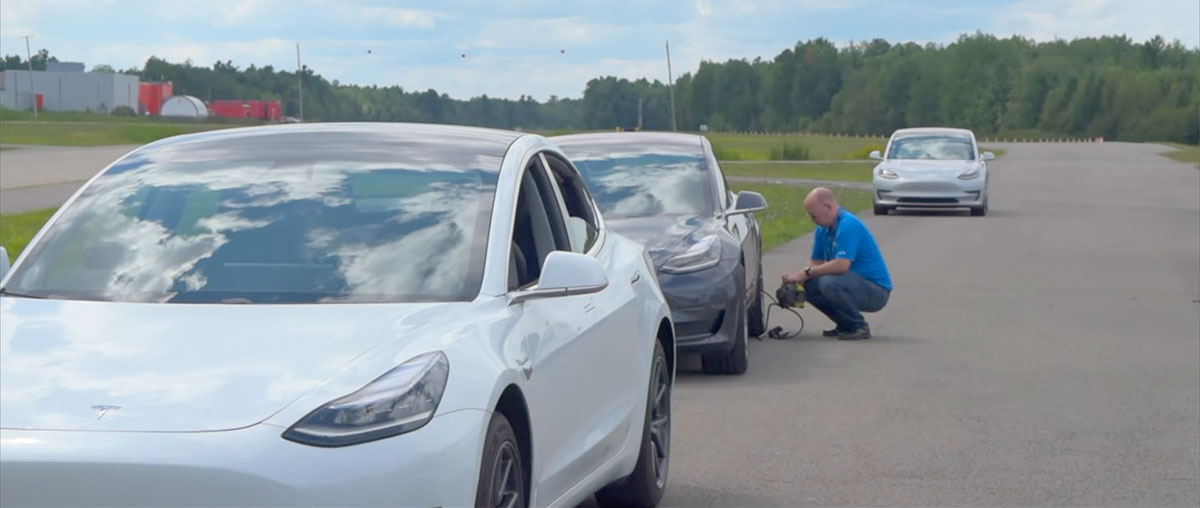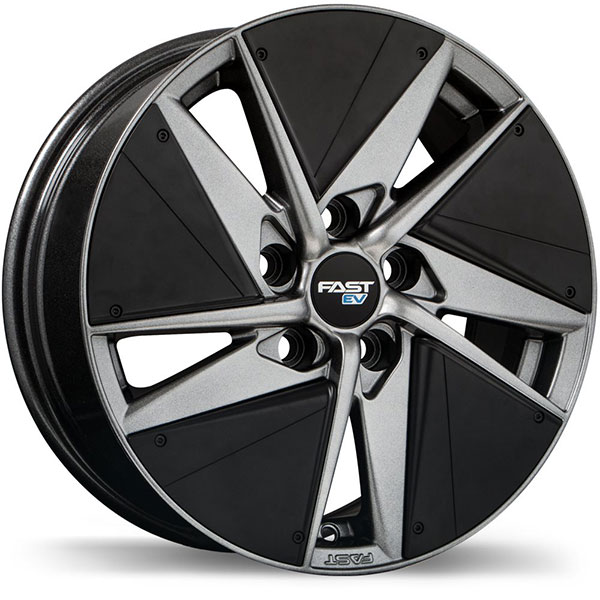
EV01+ wheels flaunt new style with the same efficiency numbers as Tesla Model 3 aeros
Way back in 2016 when I camped outside the Montreal Tesla store for two nights to reserve my Tesla Model 3 Performance, I can’t say I had wheels on my mind. There were many other things, obviously excitement wondering what the car would actually look like, the experience of meeting so many amazing people from the Tesla community, staving off frostbite… but in that exact moment any impact about what this car would have on my work life in the aftermarket wheel industry was pretty far down the list.
However it wasn’t long after I returned from this expedition that one of our Product Development managers at Fast Wheels, Ryan MacDonald, came to me and said “this whole EV thing seems to be seriously blowing up, maybe we ought to design a dedicated line for them?”
At that instant, I had a seriously hard time imagining what that would be. Lightweight? We already had tons of choices. Aerodynamic? Yes, that made more sense. But all the aero-optimized wheels I’d seen to date were OEM efforts and were, to be kind, not exactly stylish. I was dubious we could be making something with enough of an efficiency advantage that enough customers would chose it over the much prettier conventional designs that we were already selling in decent numbers to the hybrids and BEVs available at that time.

Above: Ian Pavelko outside Tesla Montreal at the delivery day of his Model 3 Performance (MAGNETO), full story in a Tesla Owners Online video.
Fast forward to about a year later and the first pre-production Model 3s started to appear on streets and proving grounds, and a number of them were wearing what we now know as the ubiquitous “Aero wheel”, a modular system consisting of an attractive lightweight Y-spoke alloy wheel with a removable full plastic aerodynamic cover. The idea was genius. Want style? Run them naked. Want extra range? Snap the covers on. Suddenly Ryan’s idea of a dedicated EV line didn’t seem so crazy, especially if we took that approach and offered it in a wide variety of sizes and specs for all different types of PHEVs and BEVs.
Early tests by owners of the Aero covers showed they did indeed boost range by about 4% to 5%. That seemed amazing to me and I felt it highly unlikely we could do better unless we just went for a straight-up Bonneville style solid disc cover, which would likely be a very small niche product at best. As the Tesla Model 3 deliveries started to grow I did spot a potential opening, many folks seemed to like the range boosting the effect of the cover but weren’t huge fans of its looks. What if we were to design a wheel that could at least approach the Aero’s benefits while offering a little more panache? And maybe try to even try to shave another pound or two off the weight?
With that target in mind, we set to work. At first, we thought about trying to adapt one of the existing lightweight designs from our Fast FC competition line, but it became clear that making those significantly more aerodynamic would be complicated, if not outright ungainly. So we threw everything out and started over with a clean sheet. The debates with the design group raged. Full cap? Inserts? Full alloy? Round and round – literally – we went. Finally in early 2019 the design you see here started to emerge, a directional-looking lightweight flow-formed base alloy wheel with five removable plastic inserts. After lots of secret-sauce aero tweaking and a little focus group help from the Tesla community on the aesthetics we were ready to start tooling, casting and testing. The final weight with inserts for the 18×8.5 Model 3 application came in at 21.4 lbs, a handy 1.6 lbs less than the Tesla Aero with the cover installed.
The physical testing part – radial fatigue, cornering fatigue, impact resistance, etc – was easy, we’d done that thousands of times, but we were still proud to get it certified to a 715 kg load rating under SAE J2530 standards, 87 kg more than the heaviest Model 3 requires and enough that we think it will even cover the Model Y. But how were we going to test the aerodynamic performance? We looked at doing computer simulations or wind tunnel tests, but I was concerned that short of blowing the entire year’s R&D budget on this one project we’d never get enough accuracy to be sure of what we had. So it had to be the real world. To date, all of the comparative tests I’d ever seen on the OE Aero wheels had been done on public roads. The methodology was good, but there are still so many variables that you can’t control such as traffic, different types of vehicles ahead causing various forms/speeds of wake turbulence, etc, that really concerned me. It had to be a controlled environment.

Enter automotive engineer and fellow member of the local Quebec Tesla community Pierre Champoux. Pierre had spent nearly 20 years working at Transport Canada’s automotive research and testing facility here in Quebec, much of that as Director of Test Operations. He insisted that their 4 miles / 6.2 km high-speed oval track was the absolute best place to get rock-solid data for our project and wasted no time in putting us in touch with the right people to make the arrangements.
Fast-forward to August and I find myself standing trackside with three Tesla Model 3s; a white SR+ with stock aero wheels that will serve as our test car for the various configurations, my own Performance Model 3 “Magneto” running on a set of our Fast FC04 competition wheels that will act as a fixed-configuration Control car to monitor any changes in weather and track conditions, and Pierre’s own Dual Motor Model 3 that will serve as a camera car for some photo laps. I would drive the Test car and the inimitable Trevor Page, the man behind the Tesla Owners Online Forum and YouTube Channel, would drive the Control car.
Every variable that could be controlled was; the tires used on the different test sets were all identical OEM Tesla spec Michelin MXM4s, right down to all treadwear readings being within 7/32nds to 8/32nds (tread height affects energy consumption, with taller/newer tread consuming more), all inflation pressures carefully set to 42 PSI cold and climate controls locked to fan speed 3 and temperature of 22 degrees C. We even booked a 1:00 pm to 6:00 pm time slot to ensure the smallest amount of temperature change over all the runs, and that worked out nicely as it stayed consistently in the 25C to 27C range throughout. Of course, we couldn’t control the wind, but being an oval track any changes there would largely be canceled out over the course of a lap.
I had decided on a test speed of 120 km/h / 75 mph, high enough to make air resistance the overwhelming energy consumption factor for the cars, but not so high that it would be out of the realm of daily use. We calibrated the speedometer differences between the test and control cars to ensure they ran at truly identical speeds and also always ensured a half-lap separation between the two cars while running together so that there would be zero chance of wake turbulence effects.
With everything finally in a place we set off on Test 1, the factory Aero wheels with no covers on. After just a few laps the tire pressures stabilized at 44 PSI front and 45 PSI rear and the energy consumption readout on the trip meter settled in and remained dead stable for the rest of the 30+ km run.
Test 1 – Tesla Aero, no cover: 182 Wh/km (baseline)
Back into the pits to set up for Test 2, factory Aero wheels again but now with Aero covers on. The same pattern emerged, within a few laps the consumption meter settled down and didn’t move for the rest of the session.
Test 2 – Tesla Aero, with cover: 173 Wh/km (5.0% reduction)
A 5% reduction, based on all the tests/claims to date, is pretty much what we were expecting. And after running what I think is the most controlled independent test so far there can be no question about it, these caps really work. Big kudos to the designers and engineers at Tesla.
Now for the moment I’d been losing sleep over for months, Test 3, our very own Fast Wheels EV01+, inserts installed. After a 20 minute stop to swap wheels and re-calibrate cold pressures one last time on this set we were back out. At first, things weren’t looking good, the consumption graph actually started to go UP. I stared in disbelief… could we have actually gotten this wrong? Am I still going to have a job tomorrow? But within two laps it began to drop dramatically, and as you can imagine a huge sigh of relief was heard from inside the car. After some contemplation, I am almost certain the anomaly was the heat buildup inside the car while it had been parked for a longer period while we changed wheels, as Trevor’s car saw a similar brief fluctuation. Even though I had cracked the windows during the stop, and we had locked the temp and fan settings, upon reentering the track the A/C compressor no doubt had to go to a way higher duty cycle to bring the temp back down inside the car. But in no time consumption dropped all the way down to 172 and settled in at reading between 173 and 174 Wh/km, staying right there for the next 25 kilometers worth of laps.

I couldn’t believe it.
Within margin-of-error, we had matched the performance of the Tesla Aero wheel. I was over the moon!
Test 3 – Fast EV01+, with inserts: 174 Wh/km (4.4% reduction)
We then ran our wheel without its aero inserts to see what that would do.
Test 4 – Fast EV01+, no inserts: 180 Wh/km (1.1% reduction)
So a slight reduction over the naked Tesla wheel, but realistically it’s not enough of a difference for me to claim any sort of victory. Still interesting though.
Test 5 was a repeat of Test 2, that is the OE Tesla Aero wheels with aero covers reinstalled. As the temps had risen by 2 degrees C over the course of the afternoon we had seen a very slight (2 Wh/km) fluctuation in our Control car, so just to be sure we had consistent data Pierre suggested we run this one again. Swap wheels hit the track for another 30 km.
Test 5 – Tesla Aero, with cover: 174 Wh/km (4.4% reduction)
That matched the high side of what we saw with the EV01+. Incredible.
So the average of the two runs with covers worked out to the Tesla Aero delivering a 4.7% reduction and the EV01+ delivered a 4.4% reduction. Considering the surface shape of the two wheels is quite different at the detail level we couldn’t have been more thrilled!
To celebrate we decided to use the remaining time we had in the session to bolt the set EV01+ to my Performance Model 3 to perform, uh, high-speed durability tests. Because if you had access to a track like this, wouldn’t you invent an excuse? Let me say that I’ve spent hours running the Autobahn at 240+ km/h and it’s definitively fun, but there’s absolutely NOTHING like doing those same speeds and hurtling into a 20 ft high, 180 degree banked turn. I have never been so happy to be a firm believer in physics. I’ll let Trevor’s video tell the rest of that story.
My thanks to the folks at PMG Technologies, Transport Canada, Pierre Champoux, Micheal Triffon for lending us his Model 3 SR+, and most especially Trevor Page, who came all the way from Toronto to not only film the entire event for you to see but helped us along every step of the testing. Trev, you da man.
For more info and ways to get the EV01+ and more Tesla/EV range, refer to: www.fastwheels.ca
Follow us on Google News ![]()
Related:
- Tesla Sentry Mode energy consumption is improving with each software update
- Tesla Model 3 vs. Tesla Model X HVAC efficiency/energy consumption test
- Attaining 260 km/h (162 mph) top speed in a Tesla Model 3 Performance at the ract track
- More by Ian: The snow rally adventure story of a Tesla Model 3 Performance




No Comments